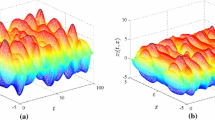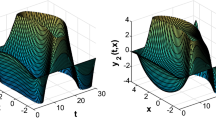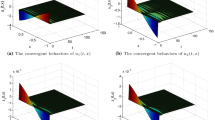Abstract
In this paper, the issue of exponential synchronization of fractional-order multilayer coupled neural networks with reaction-diffusion terms is investigated by using periodically intermittent control. It deserves to mention that spatial diffusions, multilayer interactions and fractional dynamics are introduced to coupled neural networks at the same time. A novel fractional-order differential inequality is established on the basis of Caputo partial fractional operator. Moreover, to realize exponential synchronization of the underlying neural networks, some sufficient conditions are presented with the help of Lyapunov method and graph theory. Theoretical results show that the exponential convergence rate is dependent on the control gain and the order of fractional derivative. Finally, an illustrative numerical example is provided to further verify the feasibility and effectiveness of our results.















Similar content being viewed by others
Explore related subjects
Discover the latest articles and news from researchers in related subjects, suggested using machine learning.References
Newman MEJ (2003) The structure and function of complex networks. SLAM Rev 45(2):167–256
Guo Y, Liu Y, Xu Y (2019) Synchronized stationary distribution of stochastic coupled systems based on graph theory. Math Meth Appl Sci 45:4444-4455
Wang ZX, He HB, Jiang GP, Cao JD (2021) Quasi-synchronization in heterogeneous harmonic oscillators with continuous and sampled coupling. IEEE Trans Syst Man Cybern -Syst 51(2):1267–1277
Zhou H, Song J, Li WX (2020) Razumikhin method to stability of delay coupled systems with hybrid switching diffusions. Nonlinear Anal Hybrid Syst 38:100934
Wang ZX, He HB, Jiang GP, Cao JD (2020) Distributed tracking in heterogeneous networks with asynchronous sampled-data control. IEEE Trans Ind Inform 16(12):7381–7391
Wu YB, Li YC, Li WX (2020) Almost surely exponential synchronization of complex dynamical networks under aperiodically intermittent discrete observations noise. IEEE T Cybern. https://doi.org/10.1109/TCYB.2020.3022296
Wang ZX, He HB (2020) Asynchronous quasi-consensus of heterogeneous multiagent systems with nonuniform input delays. IEEE Trans Syst Man Cybern Syst 50(8):2815–2827
Chatterjee S, Sarkar S, Hore S, Dey N, Ashour AS, Balas VE (2017) Particle swarm optimization trained neural network for structural failure prediction of multistoried RC buildings. Neural Comput Appl 28(8):2005–2016
Xu DS, Liu Y, Liu M (2021) Finite-time synchronization of multi-coupling stochastic fuzzy neural networks with mixed delays via feedback control. Fuzzy Sets Syst 411:85–104
Wang YQ, Lu JQ, Li XD, Liang JL (2020) Synchronization of coupled neural networks under mixed impulsive effects: a novel delay inequality approach. Neural Netw 127:38–46
Xie X, Liu XZ, Xu HL (2019) Synchronization of delayed coupled switched neural networks: mode-dependent average impulsive interval. Neurocomputing 365:261–272
Zhang ZQ, Ren L (2019) New sufficient conditions on global asymptotic synchronization of inertial delayed neural networks by using integrating inequality techniques. Nonlinear Dyn 95(2):905–917
Katchinskiy N, Goez HR, Dutta I, Godbout R, Elezzabi AY (2016) Novel method for neuronal nanosurgical connection. Sci Rep 6:20529
Zhao X, Lu XJ, Zeng ZJ (2021) Synchronized stationary distribution for stochastic multi-links systems with Markov jump. Nonlinear Anal Hybrid Syst 40:101006
Hou J, Huang YL, Ren SY (2019) Anti-synchronization analysis and pinning control of multi-weighted coupled neural networks with and without reaction-diffusion terms. Neurocomputing 330:78–93
Tang HA, Wang JL, Wang LD, Hu XF, Zhou Y, Duan SK (2019) Impulsive control for passivity and exponential synchronization of coupled neural networks with multiple weights. J Frankl Inst Eng Appl Math 356(10):5434–5463
Zhang H, Zeng ZG, Han QL (2019) Synchronization of multiple reaction-diffusion neural networks with heterogeneous and unbounded time-varying delays. IEEE T Cybern 49(8):2980–2991
Wang JL, Wu HN, Guo L (2011) Passivity and stability analysis of reaction-diffusion neural networks with dirichlet boundary conditions. IEEE Trans Neural Netw 22(12):2105–2116
Ma Q, Feng G, Xu SY (2013) Delay-dependent stability criteria for reaction-diffusion neural networks with time-varying delays. IEEE T Cybern 43(6):1913–1920
Lin JZ, Xu R, Li LC (2020) Turing-Hopf bifurcation of reaction-diffusion neural networks with leakage delay. Commun Nonlinear Sci Numer Simul 85:105241
Tyagi S, Abbas S, Kirane M (2018) Global asymptotic and exponential synchronization of ring neural network with reaction-diffusion term and unbounded delay. Neural Comput Appl 30(2):487–501
Liu LJ, Chen WH, Lu XM (2018) Impulsive \(H_{\infty }\) synchronization for reaction-diffusion neural networks with mixed delays. Neurocomputing 272:481–494
Yang XS, Song Q, Cao JD, Lu JQ (2019) Synchronization of coupled Markovian reaction-diffusion neural networks with proportional delays via quantized control. IEEE Trans Neural Netw Learn Syst 30(3):951–958
Ezzat MA (2012) State space approach to thermoelectric fluid with fractional order heat transfer. Heat Mass Transf 48(1):71–82
Lu C, Sun G, Zhang Y (2021) Stationary distribution and extinction of a multi-stage HIV model with nonlinear stochastic perturbation. J Appl Math Comput. https://doi.org/10.1007/s12190-021-01530-z
Niedziela M, Wlazlo J (2008) Notes on computational aspects of the fractional-order viscoelastic model. J Eng Math 108(1):91–105
Li HL, Hu C, Cao JD, Jiang HJ, Alsaedi A (2019) Quasi-projective and complete synchronization of fractional-order complex-valued neural networks with time delays. Neural Netw 118:102–109
Xu Y, Yu JT, Li WX, Feng JQ (2021) Global asymptotic stability of fractional-order competitive neural networks with multiple time-varying-delay links. Appl Math Comput 389:125498
Peng X, Wu HQ (2020) Non-fragile robust finite-time stabilization and H infinity performance analysis for fractional-order delayed neural networks with discontinuous activations under the asynchronous switching. Neural Comput Appl 32(8):4045–4071
Xu Y, Gao S, Li WX (2020) Exponential stability of fractional-order complex multi-links networks with aperiodically intermittent control. IEEE Trans Neural Netw Learn Syst. https://doi.org/10.1109/TNNLS.2020.3016672
Xu Y, Wang Q, Li WX, Feng JQ (2021) Stability and synchronization of fractional-order delayed multilink complex networks with nonlinear hybrid couplings. Math Meth Appl Sci 44(5):3356–3375
Stamova I, Stamov G (2017) Mittag-Leffler synchronization of fractional neural networks with time-varying delays and reaction-diffusion terms using impulsive and linear controllers. Neural Netw 96:22–32
Lv YJ, Hu C, Yu J, Jiang HJ, Huang TW (2020) Edge-based fractional-order adaptive strategies for synchronization of fractional-order coupled networks with reaction-diffusion terms. IEEE T Cybern 50(4):1582–1594
Sun WJ, Ren GJ, Yu YG, Hai XD (2020) Global synchronization of reaction-diffusion fractional-order memristive neural networks with time delay and unknown parameters. Complexity 2020:4145826
Stamova IM, Simeonov S (2018) Delayed reaction-diffusion cellular neural networks of fractional order: Mittag-Leffler stability and synchronization. J Comput Nonlinear Dyn 13(1):11–15
Xu Y, Chu CY, Li WX (2018) Quantized feedback control scheme on coupled systems with time delay and distributed delay: a finite-time inner synchronization analysis. Appl Math Comput 337:315–328
Liu Y, Wang M, Chu DH, Su H (2021) Feedback control based on discrete-time state observations on synchronization of stochastic impulsive coupled systems. Nonlinear Anal Hybrid Syst 39:100987
Li S, Zhang BG, Li WX (2021) Stabilisation of multi-weights stochastic complex networks with time-varying delay driven by G-Brownian motion via aperiodically intermittent adaptive control. Int J Control 94(1):7–20
Zhou PP, Cai SM, Shen JW, Liu ZR (2018) Adaptive exponential cluster synchronization in colored community networks via aperiodically intermittent pinning control. Nonlinear Dyn 92(3):905–921
Liu Y, Liu J, Li WX (2020) Stabilization of highly nonlinear stochastic coupled systems via periodically intermittent control. Control IEEE Trans Autom. https://doi.org/10.1109/TAC.2020.3036035
Xu LG, Liu W, Hu HX, Zhou WS (2019) Exponential ultimate boundedness of fractional-order differential systems via periodically intermittent control. Nonlinear Dyn 96(2):1665–1675
Xu Y, Li Q, Li WX (2019) Periodically intermittent discrete observation control for synchronization of fractional-order coupled systems. Commun Nonlinear Sci Numer Simul 74:219–235
Podlubny I (1999) Fractional differential equations. Academic Press, New York
Hu C, Jiang HJ, Teng ZD (2010) Impulsive control and synchronization for delayed neural networks with reaction-diffusion terms. IEEE Trans Neural Netw 21(1):67–81
Li MY, Shuai ZS (2010) Global-stability problem for coupled systems of differential equations on networks. J Differ Equ 248(1):1–20
Jia Q, Tang WKS (2020) Event-based tracking consensus for multiagent systems with volatile control gain. IEEE T Cybern. https://doi.org/10.1109/TCYB.2020.3027039
Jia Q, Mwanandiye ES, Tang WKS (2020) Master-slave synchronization of delayed neural networks with time-varying control. IEEE Trans Neural Netw Learn Syst. https://doi.org/10.1109/TNNLS.2020.2996224
Cai SM, Lei XQ, Liu ZR (2016) Outer synchronization between two hybrid-coupled delayed dynamical networks via aperiodically adaptive intermittent pinning control. Complexity 21(S2):593–605
Zhou PP, Shi JY, Cai SM (2020) Pinning synchronization of directed networks with delayed complex-valued dynamical nodes and mixed coupling via intermittent control. J Frankl Inst Eng Appl Math 357(17):12840–12869
Wang PF, Wang RF, Su H (2021) Stability of time-varying hybrid stochastic delayed systems with application to aperiodically intermittent stabilization. IEEE T Cybern. https://doi.org/10.1109/TCYB.2021.3052042
Acknowledgements
The authors really appreciate the valuable comments of the editors and reviewers. This work was supported by Shandong Province Natural Science Foundation (Nos. ZR2018MA005, ZR2018MA020, ZR2017MA008); the Key Project of Science and Technology of Weihai (No. 2014DXGJMS08) and the Innovation Technology Funding Project in Harbin Institute of Technology (No. HIT.NSRIF.201703).
Author information
Authors and Affiliations
Corresponding author
Ethics declarations
Conflicts of interest
The authors have no conflicts of interest to declare that are relevant to the content of this article.
Additional information
Publisher's Note
Springer Nature remains neutral with regard to jurisdictional claims in published maps and institutional affiliations.
Appendices
Appendix A
Proof
Since matrix \({\hat{M}}\) is a symmetric and positive definite matrix, there exists an orthogonal matrix \(P\in {\mathbb {R}}^{n\times n}\) and a diagonal matrix \(\Lambda =\mathrm {diag}\{\lambda _{1},\lambda _{2},\ldots , \lambda _{n}\}\in {\mathbb {R}}^{n\times n}\) such that \(P\Lambda P^{\mathrm {T}}={\hat{M}}\), in which \(\lambda _{i}>0\). Then, we can see that
Let \(\Phi (x,t)=P^{\mathrm {T}}\Psi (x,t)\), where \(\Phi (x,t)=\left( \Phi _{1}(x,t),\Phi _{2}(x,t),\ldots ,\Phi _{n}(x,t)\right) ^{\mathrm {T}}\). According to (19), one has
Noticing that \(\Lambda\) is diagonal, we derive\(\Phi ^{\mathrm {T}}(x,t)\Lambda \Phi (x,t)=\sum _{i=1}^{n}\lambda _{i}\Phi _{i}^{2}(x,t).\) That is to say for \(\forall \alpha \in (0,1],~t\ge t_{0}\)
Applying Lemma 3, due to \(\lambda _{i}>0\), in line with (20), it is obtained that
Since \(\lambda _{i}\) is the diagonal element of matrix \(\Lambda\), it is clear that
Consequently, combined with (21), for \(\forall \alpha \in (0,1],~t\ge t_{0}\), we state that
Considering \(\Phi (x,t)=P^{\mathrm {T}}\Psi (x,t)\), for \(\forall \alpha \in (0,1],~t\ge t_{0}\), we obtain
Rearranging and using \(P\Lambda P^{\mathrm {T}}={\hat{M}}\) into (22), for \(\forall \alpha \in (0,1],~t\ge t_{0}\), it is concluded that
This completes the proof. \(\square\)
Appendix B
Proof
When \(t\in T_m^c\), in view of (5), there is a nonnegative function A(t) such that
Taking Laplace transform of (23), we have
where \({\mathbb {V}}(s)\) and \({\mathbb {A}}(s)\) denote the Laplace transform of V(t) and A(t), respectively. Then, taking inverse Laplace transform of (24), we get
where \(*\) represents the convolution operator. Since \((t-T_{m})^{\alpha }\) and \(E_{\alpha ,\alpha }(-\zeta _{1}\left( t-T_{m}\right) ^{\alpha })\) are nonnegative functions, it yields that
When \(t\in T_m^r\), based on (5), there exists a nonnegative function B(t) such that
Similarly to the case of \(t\in T_m^c\), for (25), one obtain
Hence, owing to the nonnegativity of \((t-(T_{m}+\theta ))^{\alpha }\) and \(E_{\alpha ,\alpha }(\zeta _{2}\left( t-(T_{m}+\theta )\right) ^{\alpha })\), it follows that
This proof is now completed. \(\square\)
Rights and permissions
About this article
Cite this article
Xu, Y., Sun, F. & Li, W. Exponential synchronization of fractional-order multilayer coupled neural networks with reaction-diffusion terms via intermittent control. Neural Comput & Applic 33, 16019–16032 (2021). https://doi.org/10.1007/s00521-021-06214-0
Received:
Accepted:
Published:
Issue Date:
DOI: https://doi.org/10.1007/s00521-021-06214-0




